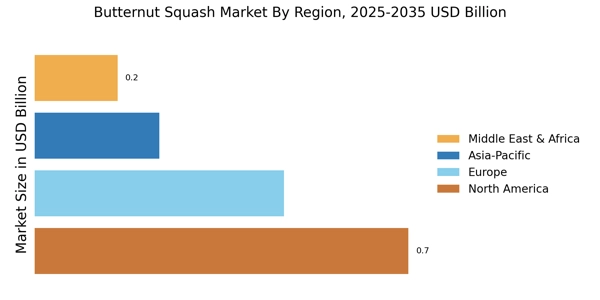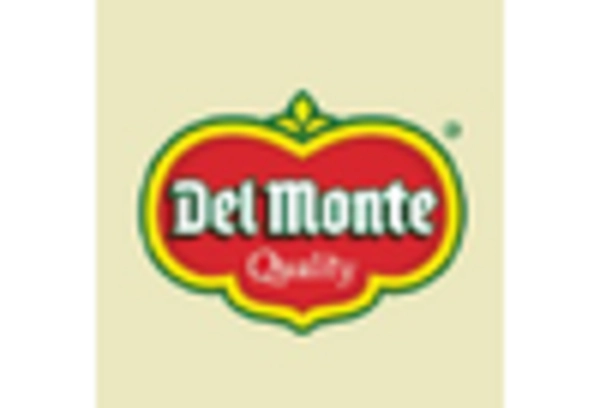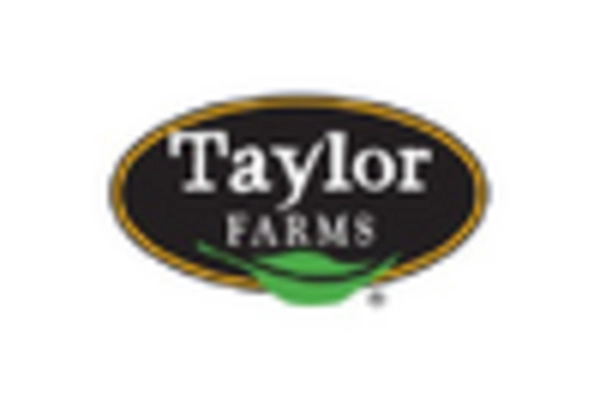Rising Health Awareness
The Butternut Squash Market is experiencing a notable surge in demand, primarily driven by increasing health consciousness among consumers. As individuals become more aware of the nutritional benefits associated with butternut squash, such as its high vitamin A content and low calorie count, the market is likely to expand. Recent data indicates that the consumption of butternut squash has risen by approximately 15% over the past year, reflecting a shift towards healthier eating habits. This trend is further supported by the growing popularity of plant-based diets, which often incorporate butternut squash as a versatile ingredient. Consequently, the Butternut Squash Market is poised for growth as more consumers seek nutritious options that align with their health goals.
Innovations in Food Processing
Innovations in food processing technologies are significantly impacting the Butternut Squash Market. Advances in preservation methods, such as freeze-drying and vacuum sealing, have enhanced the shelf life and convenience of butternut squash products. This has led to an increase in the availability of ready-to-eat meals and snacks featuring butternut squash, appealing to busy consumers. Market data suggests that the processed butternut squash segment has grown by 20% in the last year, indicating a shift in consumer preferences towards convenient food options. As food manufacturers continue to innovate, the Butternut Squash Market is likely to benefit from a broader range of products that cater to diverse consumer needs.
Sustainability and Organic Farming
Sustainability concerns are increasingly influencing consumer choices, thereby impacting the Butternut Squash Market. As consumers become more environmentally conscious, there is a growing preference for organic and sustainably sourced produce. The organic segment of the butternut squash market has seen a remarkable increase, with sales rising by approximately 30% in the last year. This trend reflects a broader movement towards sustainable agriculture practices, which not only benefit the environment but also enhance the quality of produce. As more farmers adopt organic farming methods, the Butternut Squash Market is likely to experience a shift towards higher quality, sustainably grown products that appeal to eco-conscious consumers.
Culinary Versatility and Global Cuisine
The culinary versatility of butternut squash is a key driver for the Butternut Squash Market. Its adaptability in various cuisines, from soups and salads to desserts, makes it a popular choice among chefs and home cooks alike. The increasing interest in global cuisine has led to a rise in the use of butternut squash in diverse recipes, further expanding its market reach. Recent trends indicate that the use of butternut squash in international dishes has increased by 18%, showcasing its growing acceptance across different culinary traditions. This versatility not only enhances the appeal of butternut squash but also positions the Butternut Squash Market for sustained growth as it caters to a wide array of consumer preferences.
Increased Popularity of Plant-Based Diets
The Butternut Squash Market is witnessing a significant boost due to the rising popularity of plant-based diets. As more individuals adopt vegetarian and vegan lifestyles, the demand for plant-based ingredients, including butternut squash, is on the rise. This trend is supported by research indicating that plant-based diets can lead to improved health outcomes, further driving consumer interest. In recent years, the market for plant-based foods has expanded by over 25%, with butternut squash being a favored ingredient in various dishes. This shift not only enhances the visibility of butternut squash in culinary applications but also positions the Butternut Squash Market favorably in a rapidly evolving food landscape.


















Leave a Comment